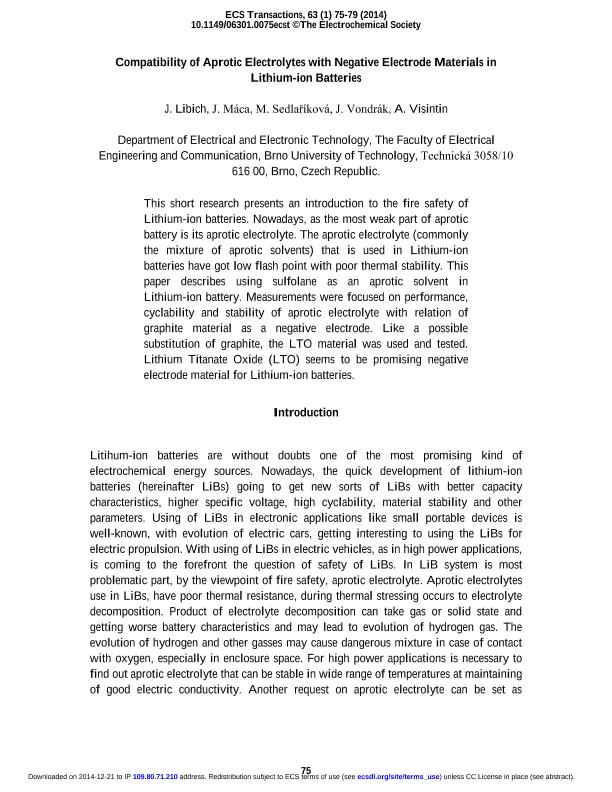Mostrar el registro sencillo del ítem
dc.contributor.author
Libich, Jiri
dc.contributor.author
Máca, J.
dc.contributor.author
Sedlaíková, M.
dc.contributor.author
Vondrák, J.
dc.contributor.author
Visintin, Arnaldo

dc.date.available
2016-04-08T17:15:30Z
dc.date.issued
2014-10
dc.identifier.citation
Libich, Jiri; Máca, J.; Sedlaíková, M.; Vondrák, J.; Visintin, Arnaldo; Compatibility of Aprotic Electrolytes with Negative Electrode Materials in Lithium-ion Batteries; Electrochemical Society; ECS Transactions; 63; 1; 10-2014; 75-79
dc.identifier.issn
1938-6737
dc.identifier.uri
http://hdl.handle.net/11336/5085
dc.description.abstract
This short research presents an introduction to the fire safety of Lithium-ion batteries. Nowadays, as the most weak part of aprotic battery is its aprotic electrolyte. The aprotic electrolyte (commonly the mixture of aprotic solvents) that is used in Lithium-ion batteries have got low flash point with poor thermal stability. This paper describes using sulfolane as an aprotic solvent in Lithium-ion battery. Measurements were focused on performance, cyclability and stability of aprotic electrolyte with relation of graphite material as a negative electrode. Like a possible substitution of graphite, the LTO material was used and tested. Lithium Titanate Oxide (LTO) seems to be promising negative electrode material for Lithium-ion batteries.
dc.format
application/pdf
dc.language.iso
eng
dc.publisher
Electrochemical Society

dc.rights
info:eu-repo/semantics/openAccess
dc.rights.uri
https://creativecommons.org/licenses/by-nc-sa/2.5/ar/
dc.subject
Litio
dc.subject
Electrolito
dc.subject
Batería
dc.subject.classification
Físico-Química, Ciencia de los Polímeros, Electroquímica

dc.subject.classification
Ciencias Químicas

dc.subject.classification
CIENCIAS NATURALES Y EXACTAS

dc.title
Compatibility of Aprotic Electrolytes with Negative Electrode Materials in Lithium-ion Batteries
dc.type
info:eu-repo/semantics/article
dc.type
info:ar-repo/semantics/artículo
dc.type
info:eu-repo/semantics/publishedVersion
dc.date.updated
2016-05-06 15:52:43.262787-03
dc.journal.volume
63
dc.journal.number
1
dc.journal.pagination
75-79
dc.journal.pais
Estados Unidos

dc.journal.ciudad
Nueva Jersey
dc.description.fil
Fil: Libich, Jiri. Brno University of Technology. The Faculty of Electrical Engineering and Communication; República Checa
dc.description.fil
Fil: Máca, J.. Brno University of Technology. The Faculty of Electrical Engineering and Communication; República Checa
dc.description.fil
Fil: Sedlaíková, M.. Brno University of Technology. The Faculty of Electrical Engineering and Communication; República Checa
dc.description.fil
Fil: Vondrák, J.. Brno University of Technology. The Faculty of Electrical Engineering and Communication; República Checa
dc.description.fil
Fil: Visintin, Arnaldo. Consejo Nacional de Investigaciones Científicas y Técnicas. Centro Científico Tecnológico la Plata. Instituto de Investigaciones Fisicoquímicas Teóricas y Aplicadas; Argentina. Universidad Nacional de la Plata; Argentina. Brno University of Technology. The Faculty of Electrical Engineering and Communication; República Checa
dc.journal.title
ECS Transactions
dc.relation.alternativeid
info:eu-repo/semantics/altIdentifier/doi/10.1149/06301.0075ecst
dc.relation.alternativeid
info:eu-repo/semantics/altIdentifier/doi/http://dx.doi.org/10.1149/06301.0075ecst
dc.relation.alternativeid
info:eu-repo/semantics/altIdentifier/url/http://ecst.ecsdl.org/content/63/1/75.abstract
Archivos asociados
